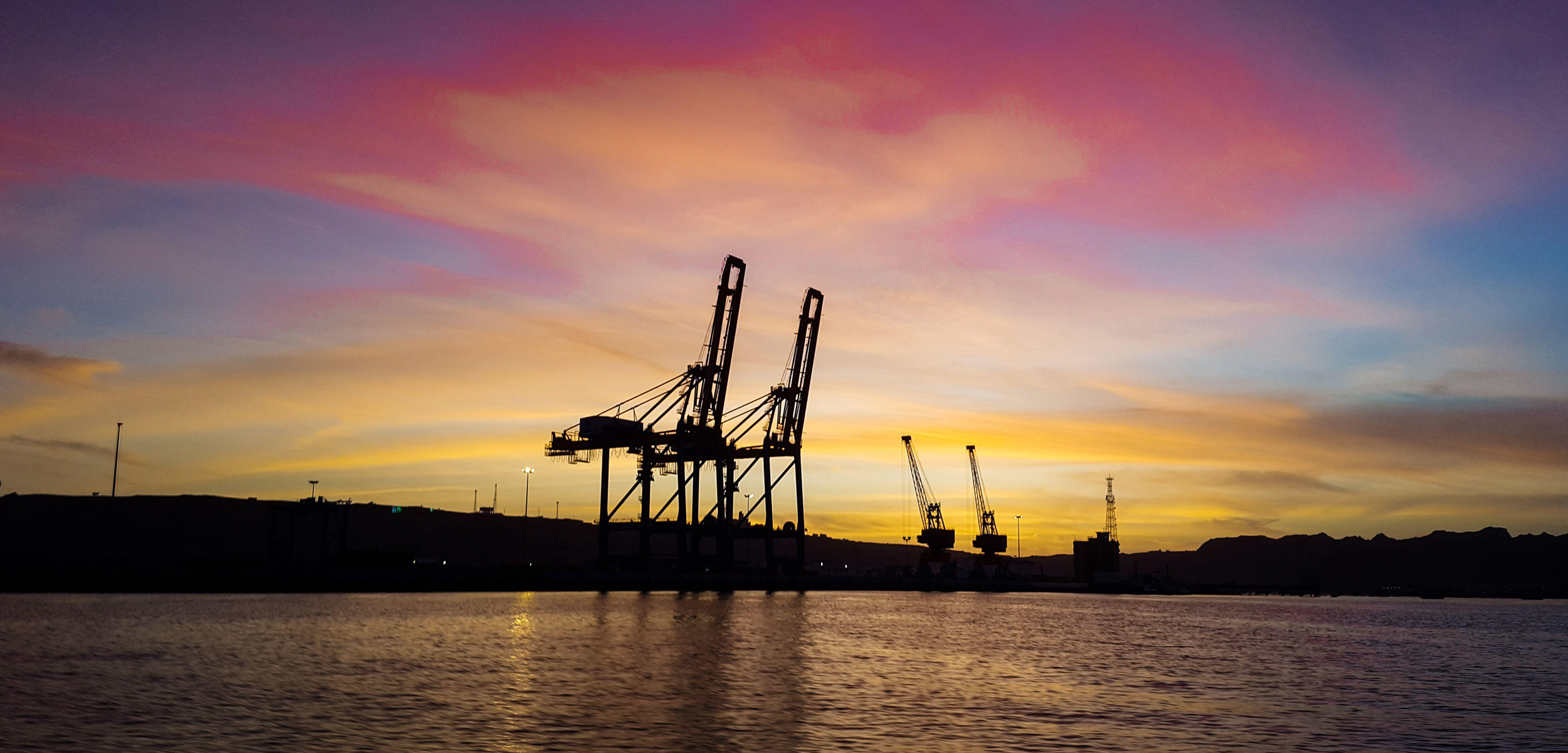Checkpoints, Machine Guns, and Fences: This Pakistani Port Is Not for the People
A massive port project—part of China’s Belt and Road Initiative—is more military base than port, further disenfranchising people in a region with a history of political tension and violence.
Article body copy
The city of Gwadar in southwestern Pakistan sits between two perfectly curved bays, on an isthmus leading to a hammerhead-shaped peninsula. Perched along the Gulf of Oman, Gwadar was a fishing village for much of its modern history; traditional fishing boats still bob in the aquamarine water, while others rest on the sandy beach that stretches along the coast. Sharp, angular hills and cliffs, carved into straight lines by harsh winds—the city’s name translates as “gateway of the wind”—tower over the sparse vegetation that punctuates the landscape. On the isthmus sits Gwadar’s Old City, where fishermen and their families have lived for generations.
On the peninsula, to the southeast and some distance from the sprawl of the Old City’s dirt tracks, dense housing, and open sewage, sits a newly constructed port complex. With its neat paving and dramatic scale, it looks like an import from another world. And in a way, it is.
Gwadar Port is the highest-profile project in China’s strategic investment in South Asia. This remote coastal outpost—with a population of just 5,000 two decades ago—lies 470 kilometers as the crow flies from Karachi, Pakistan’s economic hub. But—if all goes according to plan—Gwadar will connect western China to key shipping routes in Asia. The Chinese and Pakistani officials pushing the plan forward have promised residents of Gwadar that the port will bring prosperity and development to the city and the surrounding area, which suffers chronic water shortages and electricity outages. But local people are skeptical.
Gwadar is situated in Balochistan, a restive province with a long history of armed insurgency and conflict with the Pakistani state. As a result, the port is militarized and heavily fortified. The surrounding area is riddled with checkpoints, fostering resentment among local people, while foreigners struggle to get visas to visit unless they’re on strictly controlled trips. These actions, ostensibly taken by the Pakistani military to secure the port complex and the Chinese workers building it, only appear to confirm the worst fears of residents: that the economic benefits will go to outsiders, while they are steadily pushed out.
In April 2015, China and Pakistan unveiled the plan for Gwadar as a key plank of the China-Pakistan Economic Corridor (CPEC). This scheme—originally valued at US $46-billion, now estimated to be worth $62-billion, although numbers are hard to pin down—aims to link northern Pakistan and western China to the deepwater seaport at Gwadar, through a 3,200-kilometer network of railways, roads, pipelines, power plants, and fiber-optic cables stretching across Pakistan. The battered Karakoram Highway in northern Pakistan is undergoing expensive repair work to make it functional throughout the year. (Currently, rain or snow can halt journeys altogether.) Prior to CPEC, a coastal highway connecting Gwadar to Karachi was completed in 2004, reducing the journey time from 48 hours to seven. Under CPEC, a new highway to connect the port to existing roads is nearing completion. The Gwadar development is one small part of China’s ambitious Belt and Road Initiative, through which China is seeking to boost trade and stimulate economic growth across Asia and beyond. It is President Xi Jinping’s signature foreign policy, involving 139 countries comprising 63 percent of the world’s population and the transportation of an estimated quarter of global goods and services.
But the reality on the ground could undermine these grand plans. Ever since Pakistan was formed in 1947, Balochistan, which joined Pakistan a year later, has been politically marginalized, underdeveloped, and home to a low-level but long-running insurgency. This has led to sporadic rebellion, including a full-scale revolt in the 1970s. The Baloch nationalist movement today is splintered. Some of its members are full-blown separatists, demanding a new independent state. Others simply want more rights within a federal Pakistan. But all share a historical set of grievances: that Balochistan is being exploited by outsiders—foreigners and people from elsewhere in Pakistan—and that this exploitation leaves locals without a fair share of Balochistan’s rich resources of copper, gold, coal, natural gas, and petroleum. Mistrust of the existing political order is widespread across the populace. In this context, many local people view the cooperation of China and Pakistan’s central government in Gwadar with intense suspicion.
“They feel that eventually China will take over Gwadar from them, that it would not belong to them anymore,” says Parveen, by phone. A young woman from Turbat, 120 kilometers northeast of Gwadar, Parveen asked that I change her name, given the risk of official reprisal for local people who speak out.
The presence of thousands of Chinese workers—ranging from engineers to manual laborers—in Gwadar, which experiences high levels of unemployment, calls attention to a deal the locals feel does not benefit them. This resentment has, at times, led to Baloch insurgents targeting Chinese workers. In May 2004, during the initial phase of the port’s construction, militants killed three Chinese engineers in Gwadar. In April 2019, Baloch insurgents boarded public buses traveling between Gwadar and Karachi and shot 14 passengers, some of whom were members of the Pakistan Navy and coast guard. In May 2019, gunmen entered the Pearl Continental, Gwadar’s only luxury hotel, and opened fire, killing five people (four hotel employees and a Pakistani soldier). On Twitter, a separatist Baloch group claimed responsibility: “Our fighters have carried out this attack on Chinese and other foreign investors.” This attack caused particular consternation; the hotel is situated next to an army base and is heavily guarded. (I stayed there in 2016 and was struck by how tight the security was in Gwadar as a whole, but particularly at the hotel.) And, in April 2021, someone filled a car with explosives and left it at the car park of the Serena Hotel in Balochistan’s capital city, Quetta. The target, apparently, was the Chinese ambassador.
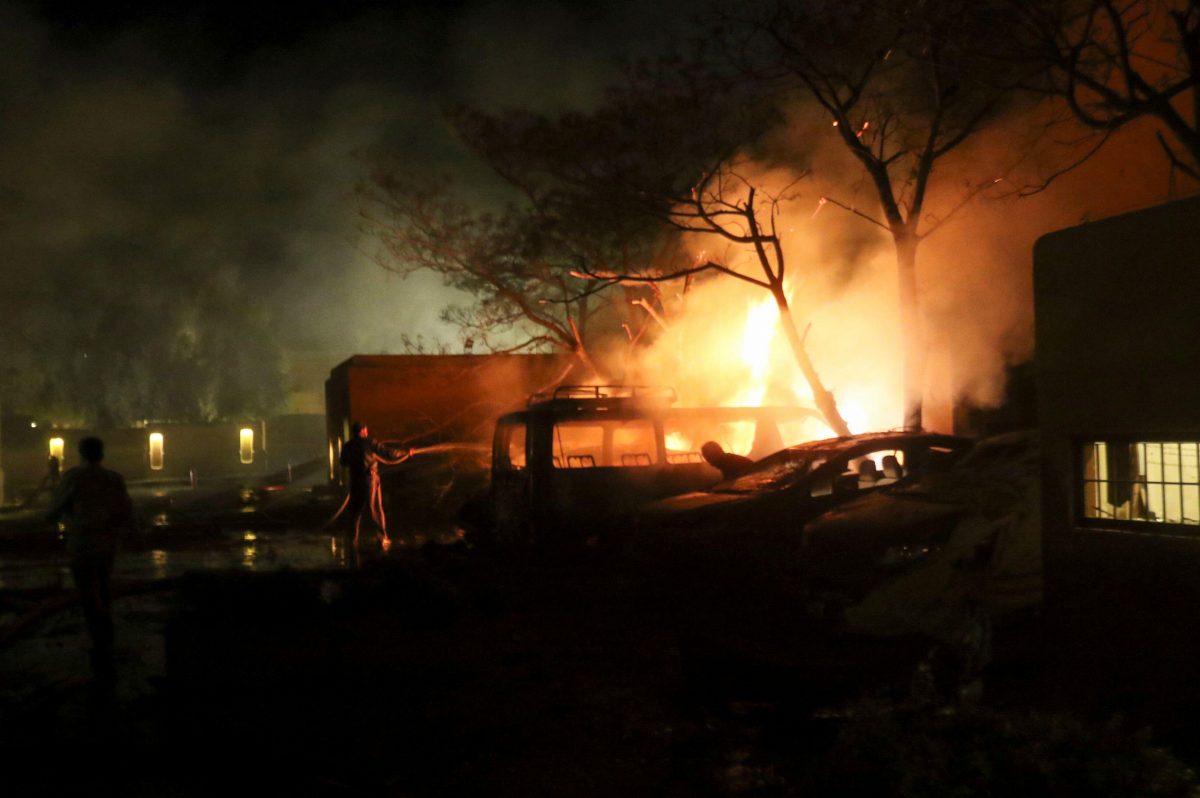
In April 2021, an explosion at a luxury hotel in Balochistan’s capital city, Quetta, reportedly targeted the Chinese ambassador. Photo by Reuters/Alamy Stock Photo
For China, the pushback is frustrating, but to those with experience in the region, it’s not surprising. “The Chinese are always in a hurry: they’ll just do it and then move on. They build the infrastructure, don’t focus on the peace, stability, their reality, or the logic behind it. They don’t like getting dragged into the local context,” says Raffaello Pantucci, a senior associate at the Royal United Services Institute, a British defense and security think tank. Pantucci wrote a book about China’s interests in Central Asia, slated for publication in spring 2022. But it is not always possible for the Chinese to avoid engaging with local dynamics: “It’s a problem when their projects have been not able to go forwards because locals are fighting them and complaining and shooting their people,” he says.
Already, Pakistan has deployed more than 15,000 soldiers and paramilitary troops to protect CPEC projects, including guarding both infrastructure of the port and Chinese workers in Gwadar. But in December 2020, the Pakistani army, in cooperation with provincial authorities, went a step further, beginning work on a fence to surround a 24-square-kilometer area of the port and parts of the city. The proposed fence, covering an area around twice the size of Heathrow Airport, would encompass the most sensitive areas of the city—the port and buildings housing offices or residences of officials—while leaving other parts of the city outside. The fence would effectively draw crude dividing lines between neighborhoods where people have lived and worked for generations.
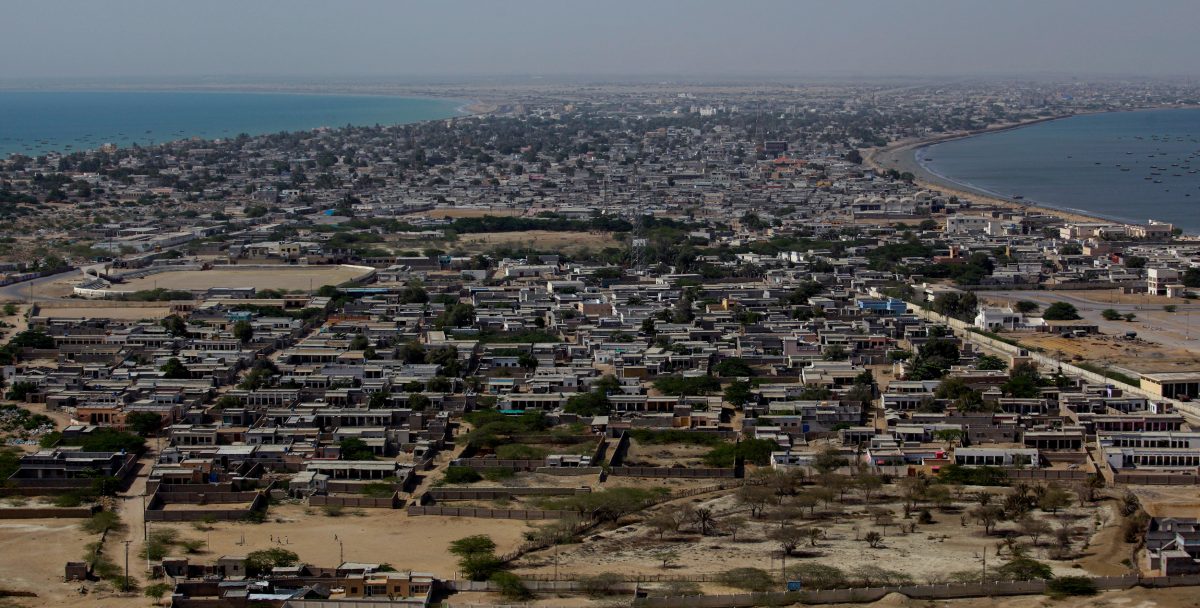
Gwadar, once a small fishing village, is about 700 kilometers from the capital of Pakistan, Karachi. Port construction is part of the China-Pakistan Economic Corridor program. Photo by Anjum Naveed/AP Images
“It was claimed that Gwadar has to be made a weapon-free city and one way to make this possible is to fence [part of it], only allowing a few guarded entry points,” says Adnan Aamir, a journalist and researcher based in Quetta, and the editor of the website Balochistan Voices. At least one government official said that fencing was necessary so that Chinese citizens can enjoy beach walks and a place to roam more freely, Aamir says.
Gwadar is a poor city, to the extent that a spate of robberies a few years back targeted not money but bottled water. Local people have long been frustrated that despite the disruption caused by the construction—a heavy military presence, checkpoints, and frequent security-related shutdowns of internet and cell services—they haven’t seen any improvement in their circumstances. They’re still short of water and electricity, they still have limited access to schools and hospitals, and many families are still struggling financially. The fence was a step too far, potentially restricting people’s movements between their homes and workplaces, or their ability to visit friends and relatives.
“People saw it as an assault on their relationships, they saw it as a stop on their mobility,” Parveen says. There was an immediate pushback. Local politicians and activists organized protests, and videos circulated on WhatsApp, a common means of sharing content in Pakistan. “There were videos in [the] Balochi [language] where people said, ‘We are not animals’—you put goats or sheep behind a fence,” Parveen says.
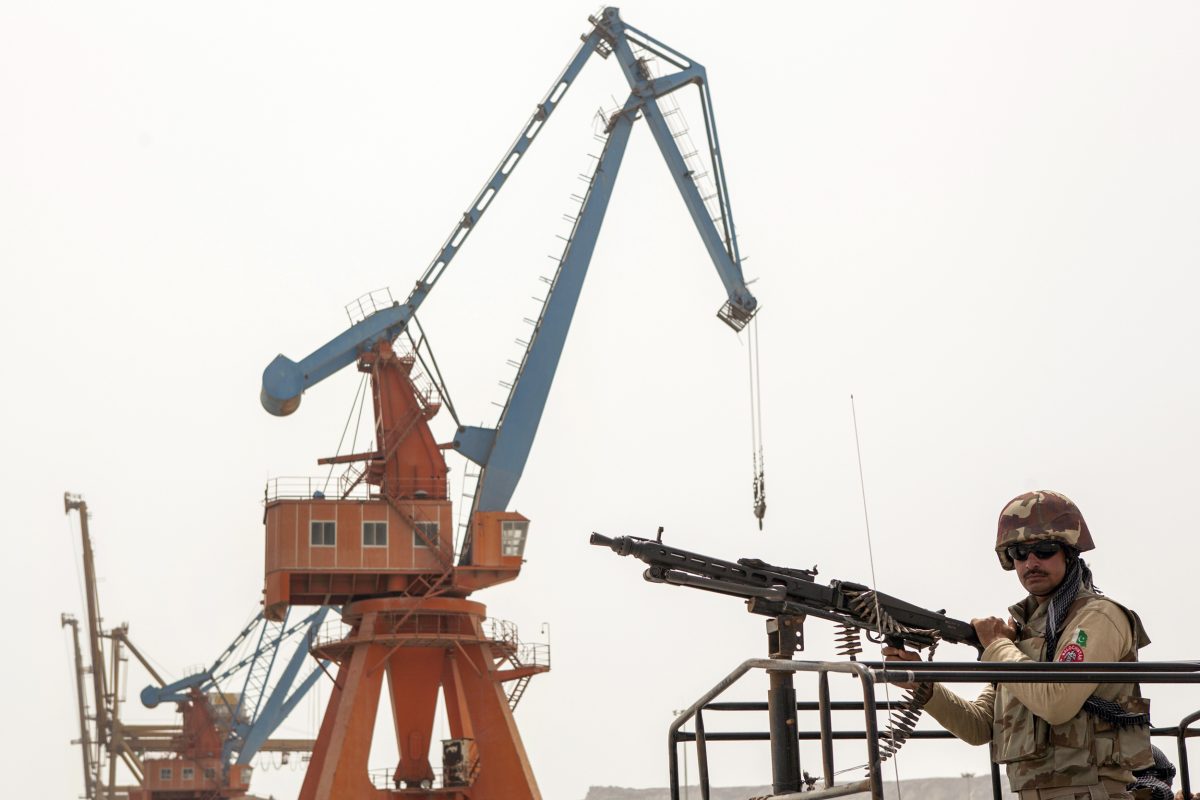
Security in Gwadar is especially high since the construction of the port began. Photo by Asim Hafeez/Bloomberg via Getty Images
In April 2016, I traveled to Gwadar on a press trip organized by Pakistan’s Inter-Services Intelligence agency. The centerpiece of the trip was a public meeting, attended by residents of Gwadar and Turbat and journalists, at which army officials and politicians answered questions from local people. Even then, five years ago, there were concerns that Gwadar would be physically walled off. In a question-and-answer session with Lieutenant General Amir Riaz, an army commander, someone asked if the Chinese would build a wall around Gwadar. “Gwadar should be secure,” Riaz responded. “But I can absolutely deny that we have had any request for a wall from anyone from China.”
The construction of the fence, beginning in December 2020, confirmed a long-standing fear. The backlash was so strong that construction stopped a few weeks after it began. But the fact that it was started at all taps into deep local anxieties about who the port development is really for. Gwadar is surrounded by wide-open expanses, empty and deserted land, but despite this remoteness, its particular geography has long drawn the eye of outside investors. It is usefully placed for shipping, situated where the Arabian Sea meets the Persian Gulf, just outside the Strait of Hormuz and close to key shipping routes. Almost 50 percent of China’s oil comes from the Persian Gulf via ships that travel over 16,000 kilometers to Shanghai. Gwadar’s port could drastically shorten the distance. It is a deep, warm-water port—and it can accommodate larger ships with heavier loads, and it won’t freeze in winter.
There was already a port at Gwadar when CPEC began in earnest in 2015. In 2002, construction on the first phase of Gwadar Port began. The project was driven forward by the military dictator Pervez Musharraf, with China as the majority funder. When he inaugurated it in 2007, Musharraf gave a speech paying tribute to the friendship between China and Pakistan. He warned that Balochistan’s “extremist elements” must surrender their weapons or be “wiped out of this area.” Pakistani officials promised that within a few years, Gwadar would be among the world’s biggest, best, and busiest seaports. That did not materialize: the port only became partially operational in November 2016, with a few shipments of Chinese goods to the Middle East and Africa. Activity since then has been limited, although in May 2021 Pakistan announced that the port was fully operational and open for bookings.
Alongside the port, in 2016 the China Overseas Ports Holding Company began construction on the $2-billion Gwadar Special Economic Zone, modeled on China’s special economic zones, which manage their economies in ways designed to attract outside investors, with freedom to set their own tax and business incentives. Today, Gwadar has a population somewhere between 80,000 and 125,000.
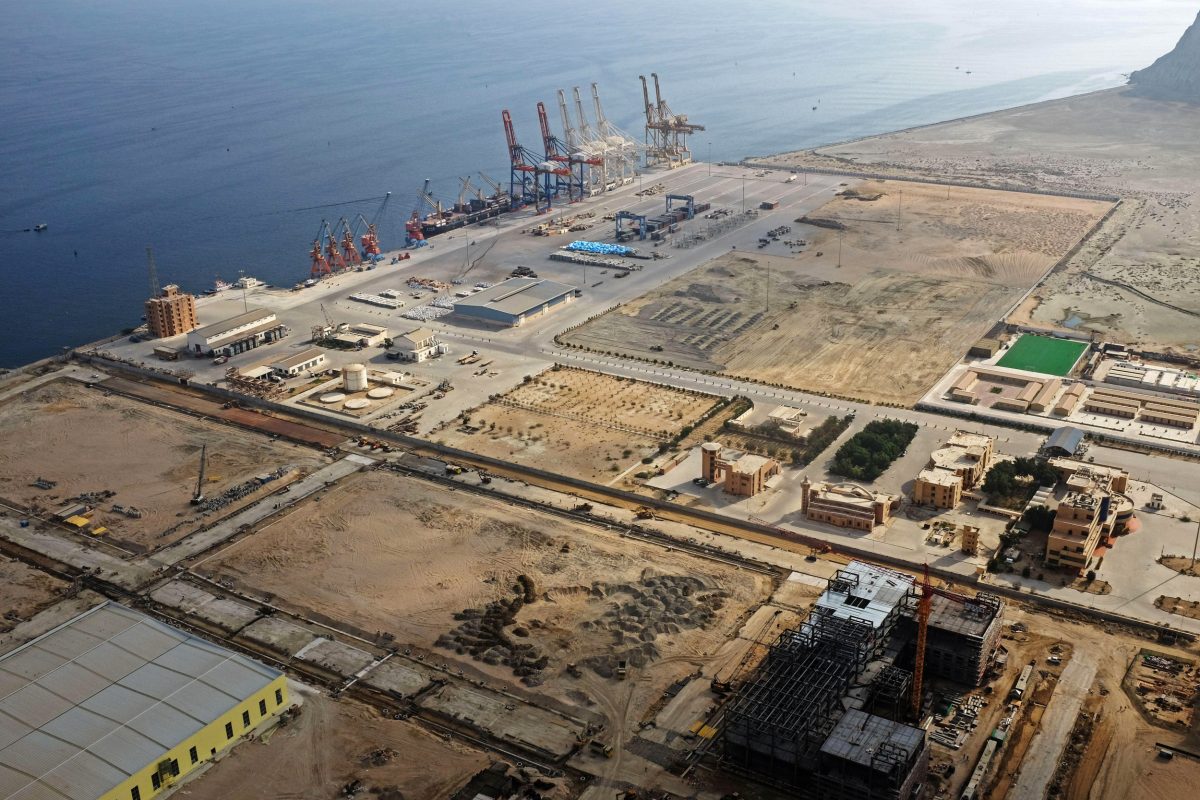
Gwadar Port will connect western China to key shipping routes in Asia. Photo by Reuters/Alamy Stock Photo
Given Balochistan’s troubled history, locals tend to see people from other provinces of Pakistan as intruders seeking to deprive local people of their own resources, so many view this influx of people with suspicion. Officials predict that the population will swell again, anticipating that by 2050 it will be home to two million people, including 20,000 Chinese workers. These officials envisage a modern city, free from insurgency and full of luxurious hotels and shopping malls, with a major international airport. (When I visited in 2016, the airport consisted of a dusty strip of tarmac serving as a runway, fronted by a blocky concrete building with a sniper positioned on top. A new airport complex is under construction.) Officials argue that this transformation will bring jobs to local people, and the ensuing prosperity will reduce the appeal of separatist militancy. But with most of the construction work going to outsiders, and investment in land and property being heavily promoted to Pakistanis from other provinces and to potential investors in other countries—a recent campaign on London buses advertised investing in Gwadar—local residents have reason to believe that the development will leave them behind.
The fence was an attempt to allay Chinese frustration with ongoing threats. “[China and Pakistan] have a strong partnership, but there are tensions,” says Pantucci. “The Chinese are unhappy in general about the Pakistani ability to deliver security outcomes.” But there is a paradox here for the Pakistani state. Every attempt it makes to reassure its Chinese allies that it is capable of managing the security threat around Gwadar only serves to exacerbate local anxieties further.
Balochistan is already highly militarized, and the port development has increased the presence of troops. Even in Turbat, Parveen has noticed an increase in troops and checkpoints due to extra measures to secure the port. “We don’t find ourselves secure, I don’t find my family secure, because ‘security’ is increased in our region,” she says. She points out that in August 2020, the paramilitary group Frontier Corps killed a Baloch student visiting his hometown of Turbat after the University of Karachi shut due to the COVID-19 pandemic. In response to a blast near the city that targeted a Frontier Corps convoy, members rounded up a few locals for “interrogation,” which ended with the death of Hayat Baloch.
The only reported statement from the Balochistan government about local anxieties came at the end of 2020, with the province’s home minister stating that the concerns of local people were important to them; the strength of local reaction appears to have stalled plans for now. “If fencing is to resume, it will further aggravate the resentment of local people against the very idea of Gwadar as the center stage of CPEC,” says Aamir, the Baloch journalist.
Parveen says she visited Gwadar Port in early 2020. Although she had permission to go there, she was questioned by soldiers from either the Pakistani army or the Frontier Corps. She was visibly local; she speaks the Balochi language and was wearing Balochi dress. “I really felt insulted,” she says, describing the experience of being questioned by soldiers, and not even being sure who they represented. “I felt that it is not for us; it is not for Baloch. We already have our past experiences, that whenever something happens in Balochistan, Baloch are not part of that. It makes the situation worse for us.”

